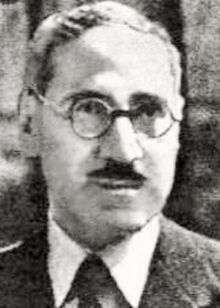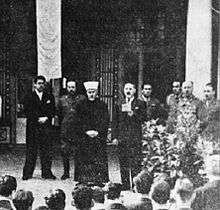Rashid Ali al-Gaylani
| Rashid Ali al-Gaylani | |
|---|---|
| رشيد عالي الكيلاني | |
 | |
| 9th Prime Minister of Iraq | |
|
In office 20 March 1933 – 9 November 1933 | |
| Monarch |
Faisal I Ghazi I |
| Preceded by | Naji Shawkat |
| Succeeded by | Jamil al-Midfai |
|
In office 31 March 1940 – 3 February 1941 | |
| Monarch |
Faisal II Prince Abdullah (Regent) |
| Preceded by | Nuri al-Said |
| Succeeded by | Taha al-Hashimi |
|
In office 13 April 1941 – 30 May 1941 | |
| Monarch |
Faisal II Prince Abdullah (Regent) |
| Preceded by | Taha al-Hashimi |
| Succeeded by | Jamil al-Midfai |
| Personal details | |
| Born |
1892 Baghdad, Iraq |
| Died |
August 28, 1965 (aged 72–73) Beirut, Lebanon |
| Political party | Party of National Brotherhood |
| Religion | Sunni Islam |
Rashid Ali al-Gaylani (Arabic: رشيد عالي الكيلاني, Arabic pronunciation: [raʃiːd ʕaːliː al.keːlaːniː]), (1892 – August 28, 1965), in Arab standard pronunciation Rashid Aali al-Kaylani, also transliterated as Sayyad Rashid Aali al-Gillani, Sayyad Rashid Ali al-Gailani, or sometimes Sayyad Rashid Ali el Keilany ['Sayyad' serves to address higher standing male persons] served as Prime Minister of the Kingdom of Iraq on three occasions. He is chiefly remembered as an Arab nationalist who attempted to remove the British influence from Iraq. During his brief tenures as Prime Minister in 1940 and 1941, he attempted to negotiate settlements with the Axis powers during World War II in order to counter British influence in Iraq.
Early life
Rashid Ali born as the son of Sayyad Abdul Wahhab al-Gaylani into the prominent Baghdad-based Gaylani family. The Gaylani were known as sadeh, signifying that they were a family of religion that traced their ancestry back to the Islamic prophet Muhammad.[1] Rashid Ali enrolled in law school in Baghdad and became a lawyer prior to his political activism.[2]
Political career
In 1924, Rashid Ali al-Gaylani began his career in politics in the first government led by Prime Minister Yasin al-Hashimi. Yasin al-Hashimi appointed Gaylani as the Minister of Justice. The two men were ardent nationalists and were opposed to any British involvement in the internal politics of Iraq. They rejected the Anglo-Iraqi Treaty signed by the government of Prime Minister Nuri as-Said in 1930. They formed the Party of National Brotherhood to promote nationalist aims. Gaylani served as Prime Minister for the first time in 1933 but held office for less than eight months. In 1938 the subject was seized and exiled to 'Ana for his suspected role in the Baghdad bomb-throwing of November and the general political upheaval.[3]
During the Hashimi government, the subject served as Minister of Interior with the additional benefit of the lucrative trusteeship of the Qadiri Awqaf. Later as Prime Minister he would retain the Interior portfolio as public works projects progressed including the laying of the foundations for a mosque to be named, the Faysal Mosque.[4]
On 31 March 1940, when Gaylani was again appointed Prime Minister, World War II had started and Iraq had just experienced the premature death of King Ghazi. Ghazi's reign was followed by a Regency for his four-year-old son who was now the new King Faisal II. Faisal's Regent was Ghazi's uncle, Emir Abdul-Illah. Abdul-Illah supported Britain in the war, but he was unable to control Gaylani, who used the war to further his own nationalist goals by refusing to allow Allied troops passage through Iraq to the front. He also rejected calls for Iraq to break its ties with Fascist Italy and sent his Justice Minister, Naji Shawkat, to Ankara to meet with Germany's ambassador to Turkey, Franz von Papen, to win German support for his government. German Foreign Ministry archives record that Shawkat met von Papen on July 5, 1940, and that he carried a letter of introduction from Mohammad Amin al-Husayni, the Grand Mufti of Jerusalem, expressing a desire for a treaty of friendship and collaboration.[5] Baghdad was the early base for Nazi Middle East intelligence operations during World War II.[6]
1941 Iraqi coup d'état

Britain responded with severe economic sanctions against Iraq. Meanwhile, news of British victories against Italian forces in North Africa dulled support for Gaylani's government, and, on 31 January 1941, under pressure from Regent Abdul-Illah, he resigned his post as Prime Minister. This only exacerbated his mistrust of Britain and its supporters in the government. Together with the members of the Golden Square, Gaylani made plans to assassinate Regent Abdul-Illah and seize power. On 31 March, Abdul Illah discovered the plot to assassinate him and fled the country.
On April 1, the coup d'état was launched and on April 3, Gaylani returned to power as Prime Minister and his "National Defence Government" replaced the government of the Regent. As one of his first acts, Gaylani sent an Iraqi artillery force to confront the RAF base situated in Habbaniya, RAF Habbaniya. By the end of April, the Iraqi armed forces were situated in strong positions on the escarpment above the base and a siege began.
Iraq had been a major supplier of petroleum to the Allied war effort and represented an important landbridge between British forces in Egypt and India. To secure Iraq, Prime Minister Winston Churchill ordered General Archibald Wavell to protect the air base at Habbaniya. On 18 April, British forces from India landed in Basra, Sabine Force. In the British Mandate of Palestine, another force was created to enter Iraq from the west and relieve RAF Habbaniya, Habbaniya Force.
Anglo-Iraqi War
At Habbaniya, the besieging Iraqis demanded the cessation of all training activities and of all flights in and out of the base. On 2 May, the commander at RAF Habbaniya, Air Vice-Marshal Harry George Smart, responded to the Iraqi demands by launching a pre-emptive strike against the Iraqi forces overlooking the air base. This action initiated the Anglo-Iraqi War. Within a week, the Iraqis abandoned the escarpment. By mid-May, British forces from Habbaniya had moved on to Fallujah and, after overcoming Iraqi resistance there, moved on to Baghdad. On 29 May, fearing a British onslaught, Gaylani fled to Persia. Before he left Baghdad, Gaylani contacted Mulla Effendi and informed him that he had chosen his house as a safe haven for the Royal family to stay until the conflict ended.
On 31 May, an armistice between the British and the Iraqis was signed. On 1 June, the Regent returned to Baghdad and his government was restored. Immediately afterwards, a violent pogrom against Jews took place in Baghdad by the hands of former Gaylani's supporters.
Persia, Germany, and Saudi Arabia

Gaylani was not to stay long in Persia. On 25 August 1941, armed forces of the United Kingdom and the Soviet Union invaded Persia and removed Reza Shah from power. Gaylani then fled to Nazi occupied Europe. In Berlin, he was received by German dictator Adolf Hitler and he was recognized as the leader of the Iraqi government in exile. Upon the defeat of Germany, Gaylani again fled and found refuge, this time in Saudi Arabia.
Later life and death
Gaylani only returned from exile after the revolution that overthrew the Iraqi monarchy in 1958. Once again he attempted to seize power, and plotted a revolt against Abdul Karim Kassem's government. The revolt was foiled and Gaylani was sentenced to death. Later pardoned, he returned to exile in Beirut, Lebanon, where he died in 1965.
See also
References
Bibliography
- Aboul-Enein, Youssef; Aboul-Enein, Basil (2013). The Secret War for the Middle East: The Influence of Axis and Allied Intelligence operations During WW. Naval Institute Press.
- Lewis, Bernard (2003). The crisis of Islam: holy war and unholy terror. Random House Publishing Group. ISBN 9781588360755.
- Longrigg, Stephen Hemsley (1953). Iraq, 1900 To 1950: A Political, Social, and Economic History. Oxford University Press.
| Political offices | ||
|---|---|---|
| Preceded by Naji Shawkat |
Prime Minister of Iraq March 20, 1933 — October 29, 1933 |
Succeeded by Jamil al-Midfai |
| Preceded by Nuri as-Said |
Prime Minister of Iraq March 31, 1940 — January 31, 1941 |
Succeeded by Taha al-Hashimi |
| Preceded by Taha al-Hashimi |
Prime Minister of Iraq April 3, 1941 — May 29, 1941 |
Succeeded by Jamil al-Midfai |